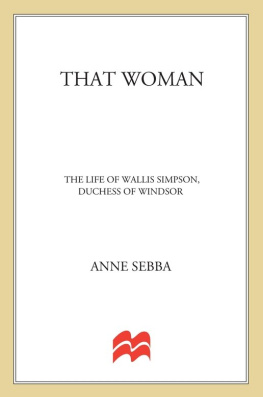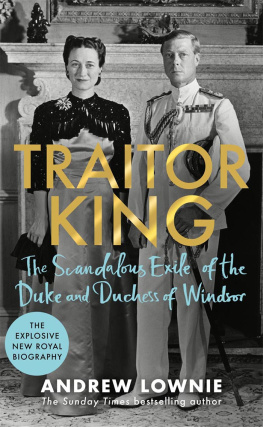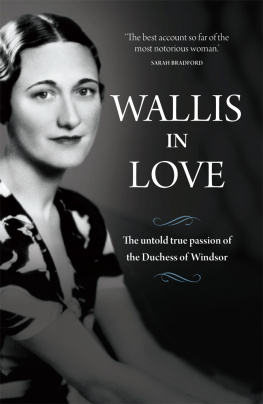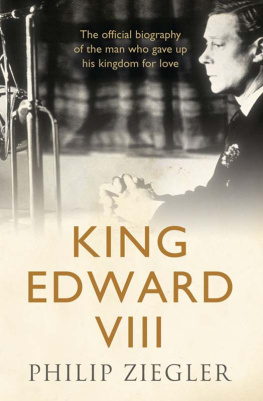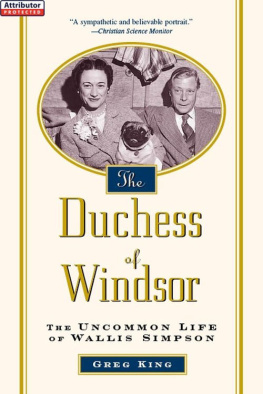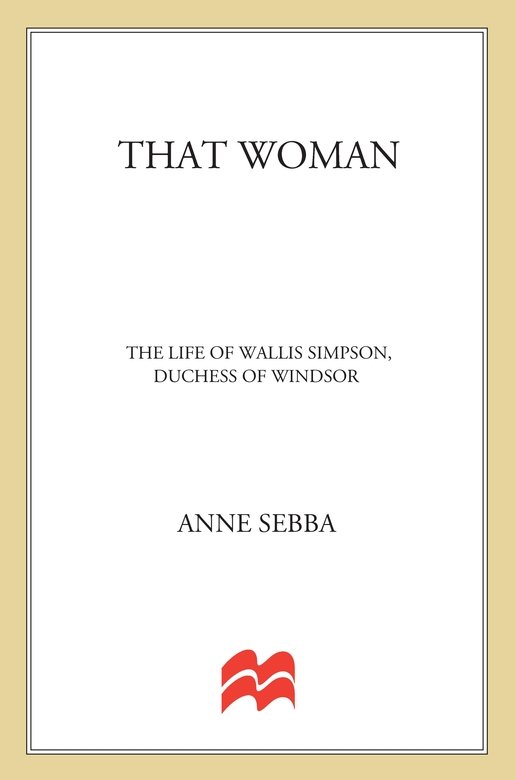No one who researches the life of Wallis Simpson can go far without looking at letters between Wallis and Edward, many of which have been edited by Michael Bloch. My first debt is to him for this sterling work which has been an invaluable guide over the last years in my quest to understand Wallis and for allowing me to quote from these. For help with understanding the British political situation in 1936, especially with respect to Stanley Baldwin, I owe an immeasurable debt of gratitude to Professor Philip Williamson, Head of History at Durham University, who has not only given up valuable time to talk through some of the issues and discuss current historical interpretations with me but has also located photocopies of documents far beyond any reasonable expectation of a biographer. I have relished our (for me) all too brief conversations and thank him most warmly for sharing his scholarship with me. I want to thank Aharon Solomons, the son of Ernest Simpson and Mary Kirk, who not only opened up his home in Mexico most generously to me, but set me on a new path to seeing Wallis Simpson and her second husband in a different light. He I thank most warmly for some unforgettable conversations and I also thank Maria-Teresa (MT) Solomons for showing me some letters and photographs. I especially want to thank Pascale Lepeu, Curator of the Cartier Collection, for a wonderfully enjoyable day seeing the Collection and Michele Aliaga at the Cartier Archive for generously making available so many wonderful Cartier images, some of which magnificently enhance this edition. My thanks also go to Erika Bard, who has once again provided me not only with original thoughts about and psychological insights into the behaviour of my subjectsbut has also given me suggestions for further examination.
There are others whom I would like to thank publicly for enormous generosity and concern for historical accuracy but who have requested anonymity. They know who they are.
I have consulted a number of libraries and archives in the hunt for new material and would particularly like to thank the Master, Fellows and Scholars of Churchill College, Cambridge and the staff of the Churchill Archives Centre especially its Director, Allen Packwood, Natalie Adams, Andrew Riley, Sophie Bridges and Katharine Thomson for their unfailing help and cooperation, especially in trying to ferret out unpublished material, newly released documents or helping me locate those due for reclassification through Freedom of Information requests while I was writing this book. For permission to quote from the Spears Papers, housed at Churchill College, I thank Patrick Aylmer and for permission to quote from the Lascelles Papers also held at Churchill College I thank the Hon. Caroline Erskine.
I also owe a debt to the staff at the National Archives in Kew who made my work more pleasant in innumerable ways and would like especially to mention Mark Dunton who, seeing my dismay at the prospect of consulting endless files on microfilm so dispiriting for all researchers encouraged me to seek permission for original documents to be brought up from the vaults including the evocative, leather-bound Cabinet Office minutes and Conclusions to Cabinet Meetings. Seeing the originals in this way adds enormously to any authors feel for the period and an understanding of the drama of events as they unfolded.
The London Library is, as ever, a most wonderful resource and again, its staff have found books that eluded me or books kept on special reserve, as did also the helpful team at the British Library. My days at the Bodleian always seemed to be accompanied by freezing weather and snow, especially testing as the collection was being moved from its permanent home to a temporary building demanding permanently open doors. But here too I encountered warmth from helpful librarians, especially Colin Harris, Helen Langley and Rebecca Wall. At Balliol College, which owns copyright for some of the Monckton Papers, my thanks go to Anna Sander. I must alsomention the Highland Park Historical Society, in particular Jean Sogin and Julia Marshall, while Dorothy Hordubay, Joan Jermakian and Judy Smith are just three among the thoughtful and kind staff at Oldfields School, Baltimore, where Gentleness and Courtesy are still the rule. At the Maryland District Historical Society, Marc Thomas has been most helpful. Lambeth Palace Archives have been a delight to discover and my thanks go to the efficient and helpful staff there too. Thanks to the Radcliffe-Schlesinger library for permission to quote from the Hollingsworth-Kirk family archive and to the Osbert Sitwell estate for permission to quote the poem Rat Week. My thanks to Miss Pamela Clark at the Royal Archives for permission to quote from a letter and memorandum from King George VI. In New York I was privileged to meet Kirk Hollingsworth, nephew of Mary Kirk, who cast his mind back many years on my account, went to great trouble to ferret out unpublished material for me (Notes for Lady Donaldson) and grant me permission to publish that for which he owned copyright while pointing out that some comments ascribed to Wallis in these notes were Buckies memory of what Wallis wrote but that he believed her memory was usually accurate. I have made strenuous attempts to contact all other copyright holders and if there are any I have inadvertently missed I will rectify this in any subsequent editions.
Many others have contributed to my understanding of this complex woman whose story is set against a critical period of world history or have helped me in other ways with my work. I should like to thank Diana Hutchins Angulo, Vicki Anstey, Andrew Barber, Damian Barr, Philp Baty, Francis Beckett, Chris Beetles, Jeremy Bigwood, Xandra Bingley, Marcus Binney, William Boyd, Piers Brendon, Victoria Buresch, Julia Cook, Stephen Cretney, The Lord Crathorne, Guiseppe DAnna, Andrew Davies, Spencer Doddington, John Entwistle, Jonathan Fenby, Susan Fox, Mark Gaulding, Sir Martin Gilbert, Laura Gillott, Vicky Ginther, Tim Godfray, Veronica Franklin Gould, Vanessa Hall Smith, Fred Hauptfuhrer, Nicholas Haslam, Angela Holdsworth, Dr Christopher Inglefield, Tess Johnston, Hans Jorgensen, Hector Kerr-Smiley, Dixie de Koning, Lee Langley, the late Walter Lees, Jonathan Leiserach, Richard and MidgeLevy, Mary S Lovell, Andrew Lownie, Paul Masai, Neil McKenna, Linda Mortimer, David Metcalfe, Shelagh Montague Brown, Charlotte Mosley, Margan Mulvihill, Pamela Norris, Dr Iain Oswald, John Carleton Paget, Lady Camilla Jessel Panufnik, Della Pascoe, Martin Pick, Michina Ponzone-Pope, Lucy Popescu, David Prest, David Pryce Jones, Jane Ridley, Susan Ronald, Dr Domenico de Sceglie, David Seidler, Harriet Sergeant, William Shawcross, Polly Schomberg, Brian Smouha, Rory Sutherland, Professor Miles Taylor, John Toler, Rose Tremain, Bernard Wasserstein, Esther Weiner, Alison Weir, Kenneth Wolfe, Lindy Woodhead, Philip Ziegler.
A special mention must go to the Ritz hotel, Walliss favourite haunt and the setting for many important unrecorded conversations in this story. Here I am indebted to Stephen Boxall and Amber Aldred for allowing us to film in their wonderful rooms and of course my thanks to John Stoddart for several terrific photos at the Ritz.
As ever, I owe gratitude to my dynamic agent, Clare Alexander, who always understood what a rewarding project I would find immersing myself in this examination of a woman and period in history. Her colleagues, especially Leah Middleton, Lesley Thorne and Cassie Metcalfe-Slovo, have all looked after me with concern and interest. Simon Berthon, too, has been excited by this story from the outset and immediately recognised the significance of the new material which was both heartening and stimulating. I have benefited enormously from discussions with him about That Woman over the past years and months. Peter James, my copy editor, deserves a special thank you for his unrivalled clarity of vision and for nobly giving up his weekends for That Woman . I am fortunate that once again Douglas Matthews has been prepared to offer his matchless indexing skills, and I thank him for this. At Weidenfeld & Nicolson, Alan Samson, Martha Ashby and Elizabeth Allen have displayed equal amounts of enthusiasm, inspiration and dedication, which have made working on the final stages of That Woman the sort of pleasure and delight which have made me the envy of my colleagues.

